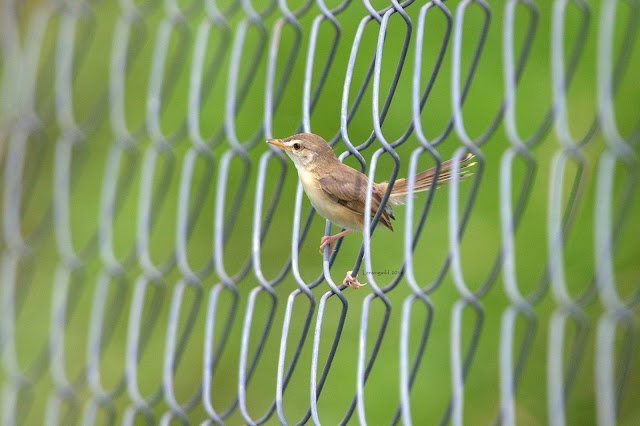We were there at Kiliyur tank by 8:30am after Sarah has gone to work. Though the morning was heralding a sunny day, the light was not that harsh; as usual the most of the ducks were still roosting. We started observing the ducks and some Northern shovelers were active and they were unusually closer to the shore. They are closer enough to make out their sexes with naked eyes. Roughly 200 shovelers were at that part of the tank. Our friend Mr. Balabharathi were already there watching the birds. When we were observing the birds, I saw a bird of prey was landing on the plant growth in one side of the tank and I started taking photos. The bird was an Eurasian Marsh-Harrier and probably it should be a female or immature one with the remaining of a shore bird in its talons. Euresian Marsh-Harrier is a winter visitor from central and northern Europe and stays closer to the wetlands and feeds on small birds, fishes, frogs and small animals. Now I could understand why the stilts and other small shore birds of this tank are always under the thorny acacia trees. This species is the largest of the harriers and has broad, rounded wings. Harriers posses very large ear openings which is disguised by the facial feathers (like owls) and hence they could detect prey species by the noises they produce.
 |
| Picture 1. Eurasian Marsh-Harrier with the remaining of a shore bird in its talons. |
Suddenly, the harrier started to fly again and in fact it was chased by a bigger bird of prey. The one that was chasing the Harrier was Greater Spotted Eagle, a migratory bird that leaves the breeding grounds in Finland, Latvia, Lithuania, Estonia, Poland, Belarus, Moldova, Russia, Ukraine, Kazakhstan, mainland China and Mongolia, for the winter and may be found in central and eastern European, north and east Africa, the Middle East, the Arabian peninsula, the Indian subcontinent and east and Southeast Asia over winter. A mature Greater Spotted Eagle weighs approximately three times of the Harrier and had a bigger wingspan. The greater spotted eagle only has white spots as a juvenile, when they extend in bands across the upperwing. By adulthood, the spots have faded leaving dark brown feathers across the head, body and wings, with slightly paler flight feathers on the upper side. Since this had the white spots at the wings, it should be a juvenile one. The greater spotted eagle is classified as Vulnerable (VU) on the IUCN Red List 2007.
The harrier was fleeing from the chasing eagle with its kill and the eagle was determined to grab this piece of food. They both were manoeuvring very skilfully and swiftly and the sky was filled with action like chasing, diving, head on collision and narrow escape. Then came the unexpected entry of a disturbed local, a crow. The crow first chased away the harrier and then the eagle that was perched in a tree to restore the peace in that region. It was a surprise to see how a small crow that could chase away two birds of prey that are bigger and mightier then it.
 |
| Picture 2. The harrier was fleeing from the chasing eagle with its kill |
 |
| Picture 3. Determined to grab this piece of food |
 |
| Picture 4. I won't leave you. |
 |
| Picture 5. Head-on? |
 |
| Picture 6. A tactical block to the fleeing Harrier |
 |
| Picture 7. Entry of the crow |
 |
| Picture 8. Get rid of the Harrier from the scene |
 |
| Picture 9. Now, YOU get lost! |










Comments